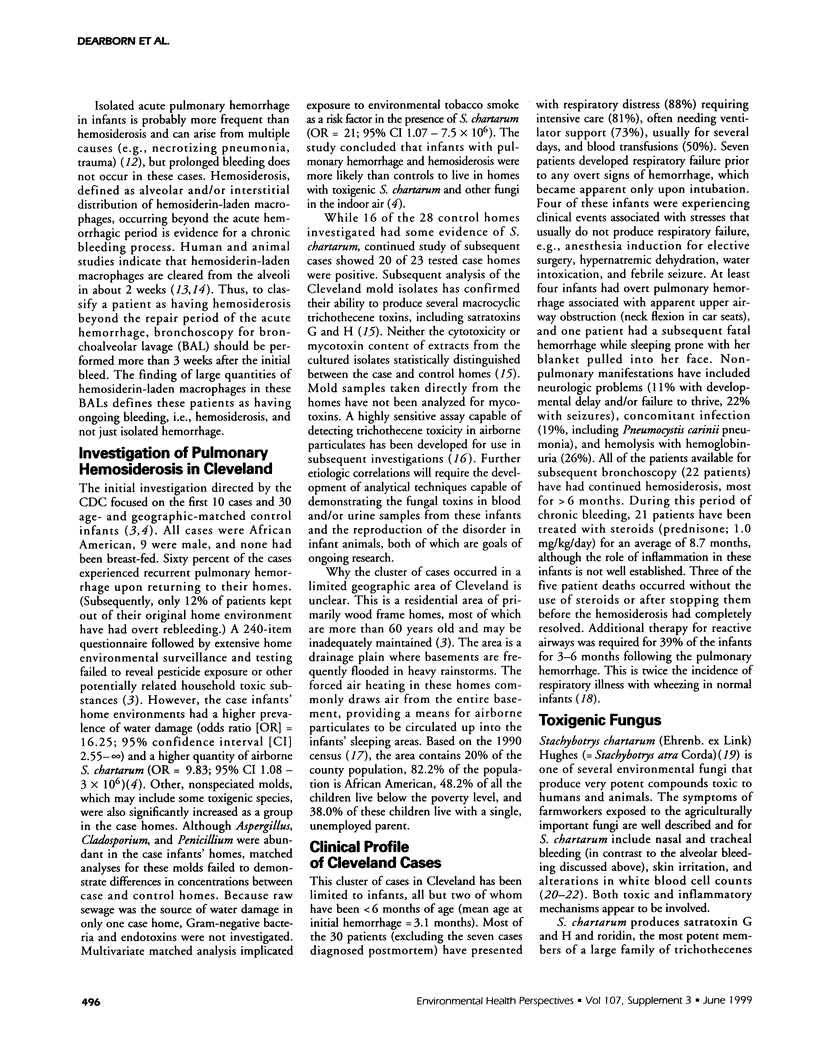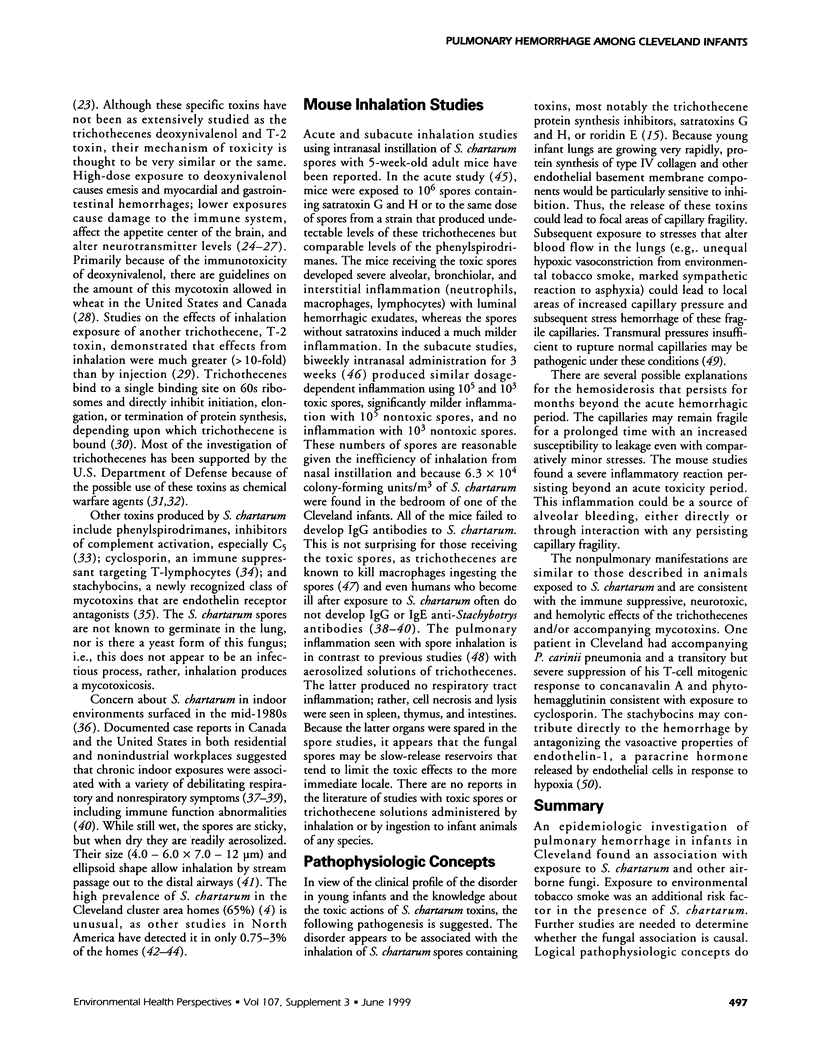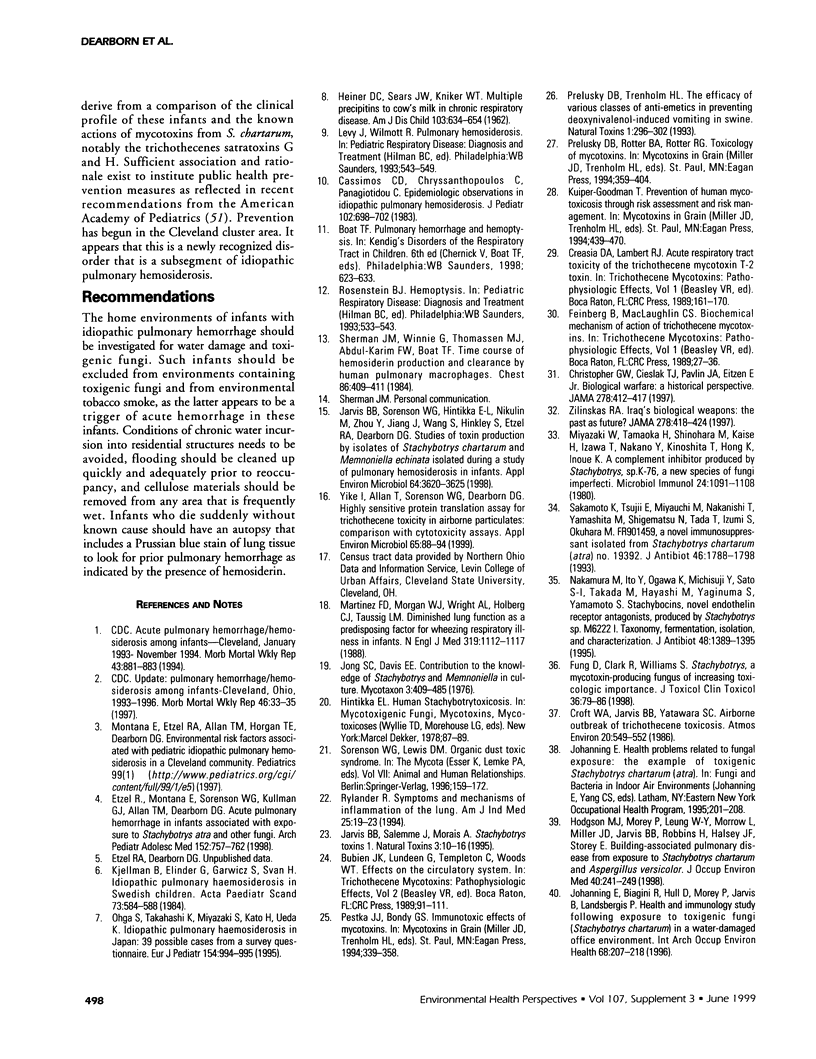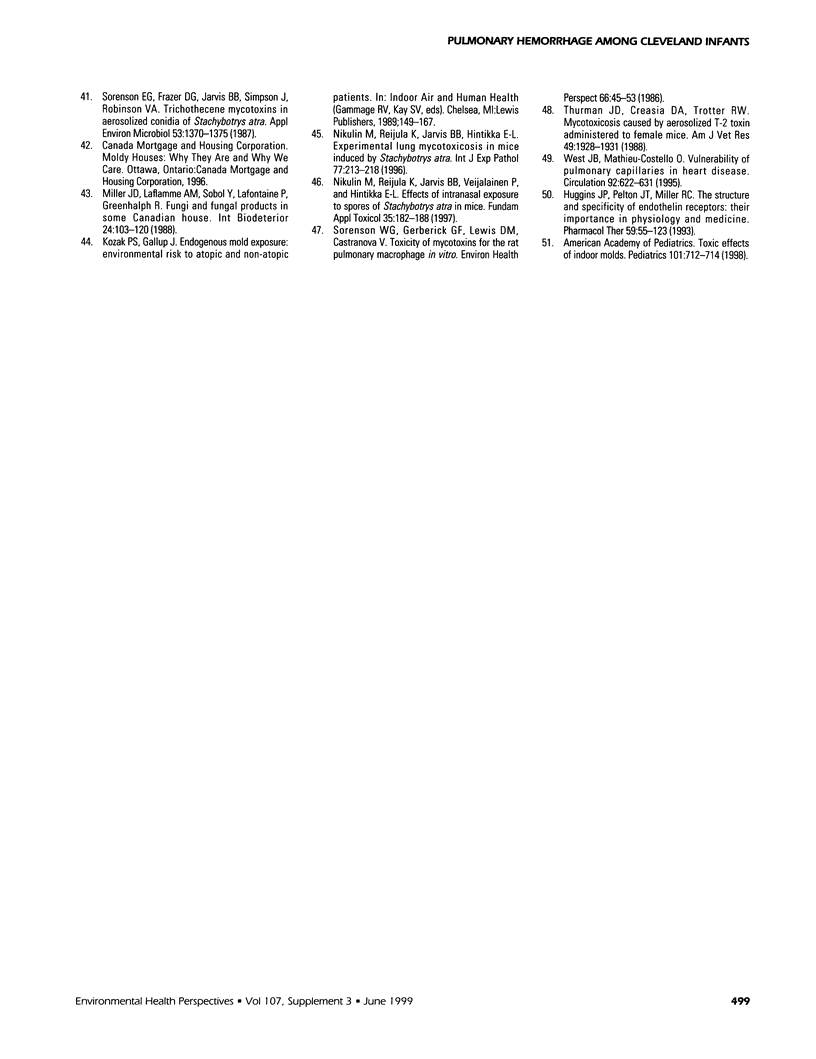Abstract
Idiopathic pulmonary hemorrhage was diagnosed in 37 infants in the Cleveland, Ohio, area between 1993 and 1998. This rare disorder has been related to 12 deaths, including 7 originally thought to be sudden infant death syndrome. Thirty of the infants were African American, all of whom lived in a limited geographic area of eastern metropolitan Cleveland, an area of older housing stock. An investigation led by the Centers for Disease Control and Prevention has found an association with household exposure to a toxigenic mold, Stachybotrys chartarum, and other fungi. The rapidly growing lungs of young infants appear to be especially vulnerable to the toxins made by toxigenic molds. Environmental tobacco smoke was frequently present in the infants' homes and may be a trigger precipitating the acute bleeding. Stachybotrys, although not thought to be a common mold, is known to have a wide geographic distribution. An additional 101 cases of acute, idiopathic pulmonary hemorrhage have been reported in infants in the United States over the past 5 years. In this overview, the investigations are summarized, the clinical profile is described, the toxicity of S. chartarum is discussed, and pathophysiologic concepts are presented.
Full text
PDF




Selected References
These references are in PubMed. This may not be the complete list of references from this article.
- Cassimos C. D., Chryssanthopoulos C., Panagiotidou C. Epidemiologic observations in idiopathic pulmonary hemosiderosis. J Pediatr. 1983 May;102(5):698–702. doi: 10.1016/s0022-3476(83)80236-4. [DOI] [PubMed] [Google Scholar]
- Christopher G. W., Cieslak T. J., Pavlin J. A., Eitzen E. M., Jr Biological warfare. A historical perspective. JAMA. 1997 Aug 6;278(5):412–417. [PubMed] [Google Scholar]
- Etzel R. A., Montaña E., Sorenson W. G., Kullman G. J., Allan T. M., Dearborn D. G., Olson D. R., Jarvis B. B., Miller J. D. Acute pulmonary hemorrhage in infants associated with exposure to Stachybotrys atra and other fungi. Arch Pediatr Adolesc Med. 1998 Aug;152(8):757–762. doi: 10.1001/archpedi.152.8.757. [DOI] [PubMed] [Google Scholar]
- Fung F., Clark R., Williams S. Stachybotrys, a mycotoxin-producing fungus of increasing toxicologic importance. J Toxicol Clin Toxicol. 1998;36(1-2):79–86. doi: 10.3109/15563659809162592. [DOI] [PubMed] [Google Scholar]
- HEINER D. C., SEARS J. W., KNIKER W. T. Multiple precipitins to cow's milk in chronic respiratory disease. A syndrome including poor growth, gastrointestinal symptoms, evidence of allergy, iron deficiency anemia, and pulmonary hemosiderosis. Am J Dis Child. 1962 May;103:634–654. [PubMed] [Google Scholar]
- Hodgson M. J., Morey P., Leung W. Y., Morrow L., Miller D., Jarvis B. B., Robbins H., Halsey J. F., Storey E. Building-associated pulmonary disease from exposure to Stachybotrys chartarum and Aspergillus versicolor. J Occup Environ Med. 1998 Mar;40(3):241–249. doi: 10.1097/00043764-199803000-00006. [DOI] [PubMed] [Google Scholar]
- Huggins J. P., Pelton J. T., Miller R. C. The structure and specificity of endothelin receptors: their importance in physiology and medicine. Pharmacol Ther. 1993;59(1):55–123. doi: 10.1016/0163-7258(93)90041-b. [DOI] [PubMed] [Google Scholar]
- Jarvis B. B., Salemme J., Morais A. Stachybotrys toxins. 1. Nat Toxins. 1995;3(1):10–16. doi: 10.1002/nt.2620030104. [DOI] [PubMed] [Google Scholar]
- Jarvis B. B., Sorenson W. G., Hintikka E. L., Nikulin M., Zhou Y., Jiang J., Wang S., Hinkley S., Etzel R. A., Dearborn D. Study of toxin production by isolates of Stachybotrys chartarum and Memnoniella echinata isolated during a study of pulmonary hemosiderosis in infants. Appl Environ Microbiol. 1998 Oct;64(10):3620–3625. doi: 10.1128/aem.64.10.3620-3625.1998. [DOI] [PMC free article] [PubMed] [Google Scholar]
- Johanning E., Biagini R., Hull D., Morey P., Jarvis B., Landsbergis P. Health and immunology study following exposure to toxigenic fungi (Stachybotrys chartarum) in a water-damaged office environment. Int Arch Occup Environ Health. 1996;68(4):207–218. doi: 10.1007/BF00381430. [DOI] [PubMed] [Google Scholar]
- Kjellman B., Elinder G., Garwicz S., Svan H. Idiopathic pulmonary haemosiderosis in Swedish children. Acta Paediatr Scand. 1984 Sep;73(5):584–588. doi: 10.1111/j.1651-2227.1984.tb09978.x. [DOI] [PubMed] [Google Scholar]
- Martinez F. D., Morgan W. J., Wright A. L., Holberg C. J., Taussig L. M. Diminished lung function as a predisposing factor for wheezing respiratory illness in infants. N Engl J Med. 1988 Oct 27;319(17):1112–1117. doi: 10.1056/NEJM198810273191702. [DOI] [PubMed] [Google Scholar]
- Miyazaki W., Tamaoka H., Shinohara M., Kaise H., Izawa T., Nakano Y., Kinoshita T., Hong K., Inoue K. A complement inhibitor produced by Stachybotrys complementi, nov. sp. K-76, a new species of fungi imperfecti. Microbiol Immunol. 1980;24(11):1091–1108. doi: 10.1111/j.1348-0421.1980.tb02914.x. [DOI] [PubMed] [Google Scholar]
- Nakamura M., Ito Y., Ogawa K., Michisuji Y., Sato S., Takada M., Hayashi M., Yaginuma S., Yamamoto S. Stachybocins, novel endothelin receptor antagonists, produced by Stachybotrys sp. M6222. I. Taxonomy, fermentation, isolation and characterization. J Antibiot (Tokyo) 1995 Dec;48(12):1389–1395. doi: 10.7164/antibiotics.48.1389. [DOI] [PubMed] [Google Scholar]
- Nikulin M., Reijula K., Jarvis B. B., Hintikka E. L. Experimental lung mycotoxicosis in mice induced by Stachybotrys atra. Int J Exp Pathol. 1996 Oct;77(5):213–218. doi: 10.1046/j.1365-2613.1996.9250323.x. [DOI] [PMC free article] [PubMed] [Google Scholar]
- Nikulin M., Reijula K., Jarvis B. B., Veijalainen P., Hintikka E. L. Effects of intranasal exposure to spores of Stachybotrys atra in mice. Fundam Appl Toxicol. 1997 Feb;35(2):182–188. [PubMed] [Google Scholar]
- Ohga S., Takahashi K., Miyazaki S., Kato H., Ueda K. Idiopathic pulmonary haemosiderosis in Japan: 39 possible cases from a survey questionnaire. Eur J Pediatr. 1995 Dec;154(12):994–995. doi: 10.1007/BF01958645. [DOI] [PubMed] [Google Scholar]
- Prelusky D. B., Trenholm H. L. The efficacy of various classes of anti-emetics in preventing deoxynivalenol-induced vomiting in swine. Nat Toxins. 1993;1(5):296–302. doi: 10.1002/nt.2620010508. [DOI] [PubMed] [Google Scholar]
- Rylander R. Symptoms and mechanisms--inflammation of the lung. Am J Ind Med. 1994 Jan;25(1):19–23. doi: 10.1002/ajim.4700250107. [DOI] [PubMed] [Google Scholar]
- Sakamoto K., Tsujii E., Miyauchi M., Nakanishi T., Yamashita M., Shigematsu N., Tada T., Izumi S., Okuhara M. FR901459, a novel immunosuppressant isolated from Stachybotrys chartarum No. 19392. Taxonomy of the producing organism, fermentation, isolation, physico-chemical properties and biological activities. J Antibiot (Tokyo) 1993 Dec;46(12):1788–1798. doi: 10.7164/antibiotics.46.1788. [DOI] [PubMed] [Google Scholar]
- Sherman J. M., Winnie G., Thomassen M. J., Abdul-Karim F. W., Boat T. F. Time course of hemosiderin production and clearance by human pulmonary macrophages. Chest. 1984 Sep;86(3):409–411. doi: 10.1378/chest.86.3.409. [DOI] [PubMed] [Google Scholar]
- Sorenson W. G., Frazer D. G., Jarvis B. B., Simpson J., Robinson V. A. Trichothecene mycotoxins in aerosolized conidia of Stachybotrys atra. Appl Environ Microbiol. 1987 Jun;53(6):1370–1375. doi: 10.1128/aem.53.6.1370-1375.1987. [DOI] [PMC free article] [PubMed] [Google Scholar]
- Sorenson W. G., Gerberick G. F., Lewis D. M., Castranova V. Toxicity of mycotoxins for the rat pulmonary macrophage in vitro. Environ Health Perspect. 1986 Apr;66:45–53. doi: 10.1289/ehp.866645. [DOI] [PMC free article] [PubMed] [Google Scholar]
- Thurman J. D., Creasia D. A., Trotter R. W. Mycotoxicosis caused by aerosolized T-2 toxin administered to female mice. Am J Vet Res. 1988 Nov;49(11):1928–1931. [PubMed] [Google Scholar]
- West J. B., Mathieu-Costello O. Vulnerability of pulmonary capillaries in heart disease. Circulation. 1995 Aug 1;92(3):622–631. doi: 10.1161/01.cir.92.3.622. [DOI] [PubMed] [Google Scholar]
- Yike I., Allan T., Sorenson W. G., Dearborn D. G. Highly sensitive protein translation assay for trichothecene toxicity in airborne particulates: comparison with cytotoxicity assays. Appl Environ Microbiol. 1999 Jan;65(1):88–94. doi: 10.1128/aem.65.1.88-94.1999. [DOI] [PMC free article] [PubMed] [Google Scholar]
- Zilinskas R. A. Iraq's biological weapons. The past as future? JAMA. 1997 Aug 6;278(5):418–424. [PubMed] [Google Scholar]


